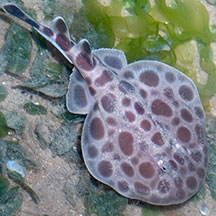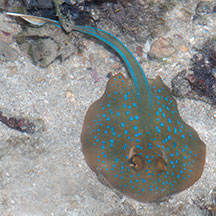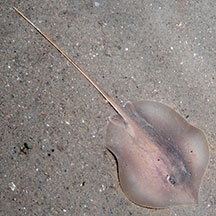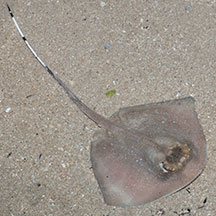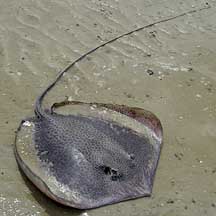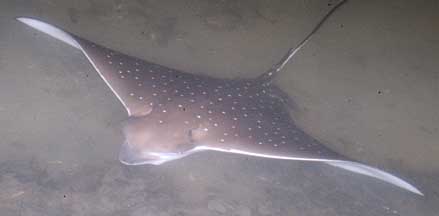| Phylum Chordata
> Subphylum Vertebrata > fishes |
Skates,
rays and stingrays
Order Rajiformes
updated
Sep 2020
if you
learn only 3 things about them ...
 They are related to sharks and have cartilage instead
of bones. They are related to sharks and have cartilage instead
of bones.
 They give birth to live young. They give birth to live young.
 They
will not sting unless you step on them. Watch your step! They
will not sting unless you step on them. Watch your step! |
|
Where
seen? Elegant
discs with bulbous eyes and a narrow tail, these large fishes are
often seen in our mangroves, seagrass meadows and coral reefs.
What are these fishes? Called
skates, rays and stingrays, these fishes belong to the Order Rajiformes
which includes 10 families. Those commonly seen on our shores at low
tide are stingrays that belong to Family
Dasyatidae. These fishes are related to sharks but most are adapted
for hunting and living on the sea bottom. For simplicity, we'll refer
to all these fishes as rays.
Features: Rays have flattened bodies with greatly enlarged
pectoral fins along their body edges. With graceful undulations of
these fins, they seem to 'fly' through the water. Some also use these
enlarged fins to bury themselves in the sand. To avoid breathing in mud and sand, water is taken in from the the
upperside of their bodies through spiracles (holes) beside their eyes.
The water is then expelled through gill slits on the underside of
the body. The snout may function as an electroreceptive organ, sensitive
to electric charges of prey buried in the ground. |
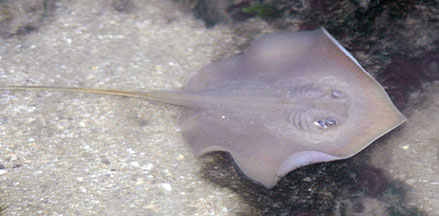
Swimming with undulations of the enlarged pectoral fins.
Pulau Sekudu, May 04 |
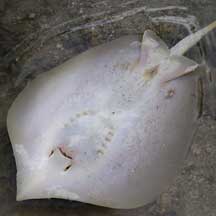 Underside. Underside.
Pulau Sekudu, May 04 |
Most rays have a long tail, with a sting - usually near where the tail
joins the body, and not at the tip of the tail. Rays are closely
related to sharks. Like sharks, the skeleton of rays are made of flexible
cartilage. If you want to know how cartilage feels like, your nose
and ears are made of cartilage!
Sometimes confused with horseshoe
crabs. In murky waters, the two animals look very similar, both
being round and flat with a long tail.
|
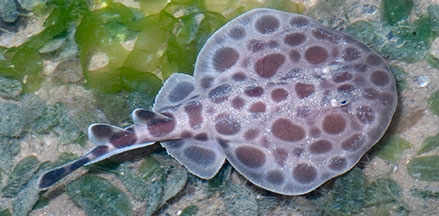
Cute but shocking: the Electric ray.
Changi, Jun
05
|
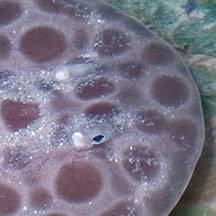
Gill openings behind the eyes. |
Stinging encounter! Stingrays are not aggressive animals
and prefer to flee from danger. Most stingray injuries
are the result of carelessness, generally when someone
accidentally steps on a stingray that is lying harmlessly
on the bottom. Stingray spines can penetrate through booties!
Shocking! Electric rays have a pair of kidney-shaped electric organs
at the base of the pectoral fins that can produce mild to strong electric
shocks. Thus their common name. Their scientific name Family Narcidae comes from the
Greek 'narke' which means 'paralysis'.
How to stay safe: Don't touch rays. Wear
covered shoes. Watch your step and walk slowly. Stingrays can be hard to spot when the water is murky. Even in clear water, ripples on the surface make them hard to spot. They can also be hidden just beneath the sand. Be aware
of your steps, if you feel a movement under your foot,
pull back and don't step down with your full body weight.
Do not step into murky water. Do not put your hand into holes and crevices. |
|
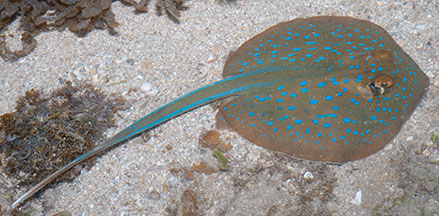
A commonly encountered stingray.
St. John's Island, Aug 08 |
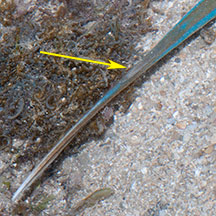
Spine near the end of the tail. |
Baby rays: Rays practice internal
fertilisation. Most rays give birth to live fully developed young,
although some may lay eggs enclosed in a capsule.
Human uses: Stingrays are a popular
seafood dish in Singapore. The large pectoral fins are barbequed and
served with chilli, often on a banana leaf. You can see their cartilageous
bones as you eat the flesh. Blue-spotted fantail
ray is also popular in the live aquarium
trade although it does not do well in captivity.
Status and threats: Our Stingrays
are not listed as endangered. However, throughout its range, the Blue-spotted
fantail ray is under pressure from over
collection for the aquarium trade and destruction of its reef habitat.
Like other creatures of the intertidal zone, Stingrays are also affected
by human activities such as reclamation and pollution. Poaching by
hobbyists and overfishing can also have an impact on local populations. |
| Some skates, rays and stingray
on Singapore shores |
Order
Rajiformes recorded for Singapore
from
Wee Y.C. and Peter K. L. Ng. 1994. A First Look at Biodiversity
in Singapore.
*from Lim, Kelvin K. P. & Jeffrey K. Y. Low, 1998. A Guide to the
Common Marine Fishes of Singapore.
+Other additions (Singapore Biodiversity Record, etc)
| |
Family
Dasyatidae (Stingrays) with list of species recorded
for Singapore
*Family Gymnuridae (Butterfly rays) |
| |
Family
Myliobatidae (Eagle, cownose and manta rays) with list
of species recorded for Singapore |
| |
+Narcine maculata (Dark-spotted numbfish) |
| |
+Narke
dipterygia (Spot-tail sleeper-ray)
Temera hardwickii (Finless sleeper-ray) |
| |
Family
Pristidae (Sawfishes) |
| |
Pristis
cuspidatus
Pristis perotheti |
| |
Family
Rhinidae (Stavenose rays) |
| |
Family
Rhinobatidae (Guitarfishes) |
| |
Platyrhina
senensis
Rhinobatus armatus
Rhinobatus granulatus
Rhinobatus thouinianus
*Rhinobatus djiddensis (White-spotted guitarfish) |
|
Links
References
- Tan Heok Hui & Kelvin K. P. Lim. Spot-tail sleeper-ray, Narke dipterygia (Chondrichthyes: Narkidae) in the Singapore Straits. 25 July 2014. Singapore Biodiversity Records 2014: 199-200 ISSN 2345-7597. National University of Singapore.
- Wee Y.C.
and Peter K. L. Ng. 1994. A First Look at Biodiversity in Singapore.
National Council on the Environment. 163pp.
- Ng, P. K.
L. & Y. C. Wee, 1994. The
Singapore Red Data Book: Threatened Plants and Animals of Singapore.
The Nature Society (Singapore), Singapore. 343 pp.
- Allen, Gerry,
2000. Marine
Fishes of South-East Asia: A Field Guide for Anglers and Divers.
Periplus Editions. 292 pp.
- Kuiter, Rudie
H. 2002. Guide
to Sea Fishes of Australia: A Comprehensive Reference for Divers
& Fishermen
New Holland Publishers. 434pp.
- Lieske,
Ewald and Robert Myers. 2001. Coral
Reef Fishes of the World
Periplus Editions. 400pp.
- Lim, S.,
P. Ng, L. Tan, & W. Y. Chin, 1994. Rhythm of the Sea: The Life
and Times of Labrador Beach. Division of Biology, School of
Science, Nanyang Technological University & Department of Zoology,
the National University of Singapore. 160 pp.
|
|
|


 Underside.
Underside.



